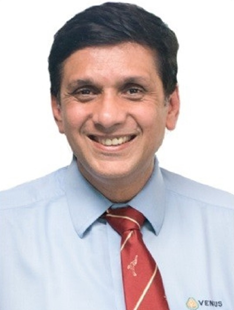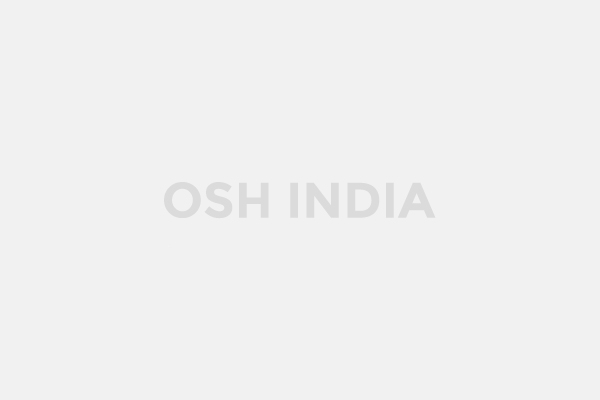Our team is going to be focused more on products which were till now only available in developed countries
Mr. Mahesh Kudav, Managing Director, Venus Safety & Health Pvt. Ltd. talks about the priorities for Venus in occupational safety and health this year, new products and innovations they plan to bring to the market this year, their plans to take the message of Occupational Safety and Health forward in India, and their expectations from the Government policies and the way forward.

Interviewed by Adeesh Sharma
What are the priorities for Venus in occupational safety and health this year?
More priorities are going to be driven by what has happened during the pandemic, and what is happening in the global world today such as the Ukraine war and the aggressive posturing by China and the subsequent response by the Western world. At Venus, we have to start thinking from the operational excellence point of view. We are into a very competitive environment with our stream of products – masks, respirators and neck-up. Safety is always a competitive stream and from an operational context we are going to be very tight when it comes to finding ways to become more competitive. The market size has increased but due to the overall economic situation there is a lot of cost-cutting happening with the industries. To serve them better we need to balance between pricing and quality.
From an innovation perspective, we will be delivering lot of new products in the coming years. We will not be going into fields where we don’t have much technical expertise but are going to develop more world-class products which can be sold or marketed globally, as well as within India. Our team is going to be focused more on products which were till now only available in developed countries.
We are going to offer world class products to our Indian community members and that whole thinking comes from being global but acting locally. So, we know that we have to offer world class products and we have to make these products globally acceptable. But at the same time we have to act local and offer them to our local community first and at a reasonable price.
The third thing that we are going to do is more from the point of view of customer centricity and so we are going to be a very approval driven company. Even today, none of our products are without approvals and this is because of our active interaction with the Bureau of Indian standards, the Ministry of Consumer Affairs and the Ministry of Textiles.
Earlier, standards would not be printed for years together. In fact, in my first communication to the Ministry of Consumer Affairs, I said that in eight years we only have the benefit of one standard getting printed in India related to OSH versus now where we have several new standards coming up every year. We are going to work actively from the customer centricity perspective with institutions like BIS to get standards on how products should be tested, on how terms should be defined or what should be the user guidance. And finally, we are also going to come up with standards on selection guide and so users will not have difficulty to find out what really the appropriate kind of PPE is.
Is there a differentiation between the products that are sold in the Indian market and those that are exported?
Not really. There are standards today that are happening in India which are similar to the ISO standards. So, the decision that Indian Government has taken is that we should have complementary standards which are in line with ISO standards. The quality is the same and if more manufacturers like us do it, then I think in the long run our country will have a very robust base of manufacturers who are export ready. And that's what drove the decision to have both the standards similar to each other.
Alright, so given this line of thinking, what new products and innovations you plan to bring to the market this year?
There are several innovations we want to bring, especially with our experience during the last 2-3 years of pandemic. We realized that Occupational Safety and health is not restricted to industries alone. There are many services or many consumers who want to also experience good products for their safety and health. For instance, a mask, which is generally required, is very uncomfortable for breathing, especially in the Indian tropical climate that is hot and humid. So, one of the innovations that we are going to launch is a product that will have close to 90% efficiency but is going to have 98% comfort.
The current products have 95% filtering efficiency and 70% comfort. So, in most of the cases, almost 80% in Occupational Safety and Health, you don't really require that standard. In most industries, you will do good with 90% protection but require 98% comfort so that more users can get and adopt PPE.
Also, recognizing the needs of the Indian industry, we are going to go much wider and deeper into getting more products approved especially Fire Protection products, self-contained building apparatus, etc. Until now our country does not have a Class 3 standard but now the government has agreed to implement it.
Soon India will have its own self-contained breathing apparatus for firemen which can be produced in India and which can be ISI certified. So, it may not be an innovation, but it will definitely be a feather in the cap for Indian industries. We are also looking at bringing various kinds of face protections and segment wise protective products especially for welders.
We plan to bring various kind of respiratory devices which will be innovative and help them to work more efficiently.
Third thing we are trying to bring-in in a big way in India is comfort and style into the eyewear.
As regards to head protection, we are going to introduce several head protection styles which we are going to concurrently market internationally and in India.
How do you now plan to take this message of Occupational Safety and Health forward in India?
We have always focused on testing our products or getting approvals on our product and giving a reassurance to everyone that our products are really great and wonderful but in coming years, you'll see more of our technical teams going to customer sites with equipment and demonstrating them how to use a product, how to select a product effectively or which product really gives them a great assurance of safety or protection. This is one of the big initiatives we are doing. We are also going to various colleges and safety institutions and trying to make them aware of Occupational Safety and Health because I think today's young generation is more health conscious when it comes to professional exposure and use of PPE. We are still in a nascent stage, so if we create an awareness in those young minds, then definitely it will give boost to spreading the OSH awareness. We are also participating in more shows like the OSH India show. We are there almost in all shows since OSH India started. But other than that we are also trying to participate in many local shows or industry oriented shows
Within our working campus, we have set certain experience centers where people can actually go through tunnels. We have got a very big underground experience center below our factory where workers or people who work in tunnels can actually go down and wear various kinds of respiratory products. So, these are some of the things which we are going to do in future to create awareness.
You being a veteran in this industry and having interacted with the government across various forums, what are your expectations with regard to policy decisions? What has been done till now and what more should be done?
I think in the last few years, particularly last 7-10 years, we have taken great strides. The first stride is the change in the Factories Act. The change in the Factories Act actually gave more clarity on the importance of PPE. OK, that was not amended since I think it was formed in 1956, but there was a major overhaul in the Factories Act coupled with that a complete overhaul in the ISI standards because most of the standards existing in India were in the 1970s and 80s era and a lot of changes were required. A lot has changed since then. The government is now very responsive when it comes to changing the standards.
Further, the government has facilitated an easy entry path for manufacturers to get ISI approvals. Earlier without your own laboratory, manufacturers could not get an approval and that was a big stumbling block to get more manufacturers on board. The process has now become less complicated for MSMEs, requires less investment and is friendlier for manufacturers, so that will give a lot of reassurance to users to get into products which require ISI certifications and we want to see more and more manufacturers getting and saying that they are ISI compliant because that's going to help us a lot. I'm also seeing the government moving towards an HSN code which is harmonized for each PPE segment.
The government has shown great inclination to say that, let's have separate HSN codes for each PPE product. Now, once that happens, then lot of trade information will be available which today is so fragmented that no one knows exactly how many PPEs are sold or what kind of PPEs are sold. But with these codes being available in the GST invoicing method itself, a lot of information will be available and the government will be able to leverage their policies to support that particular trade or to make that particular industry segment grow. What more is required is implementation of regulatory policies.
So, the government on their part should make people more aware on regulations around PPE, whether it is helmets or whether it is safety belts, especially among MSMEs that account for 40% of our production and they also account for close to the same percentage of the workforce. The MSMEs are very fragmented in our country and to approach this fragmented sector is going to be a big challenge in the coming years. But organizations like OSH India Expo, DISH, Government and manufacturers need to work together to get these people onboard.



